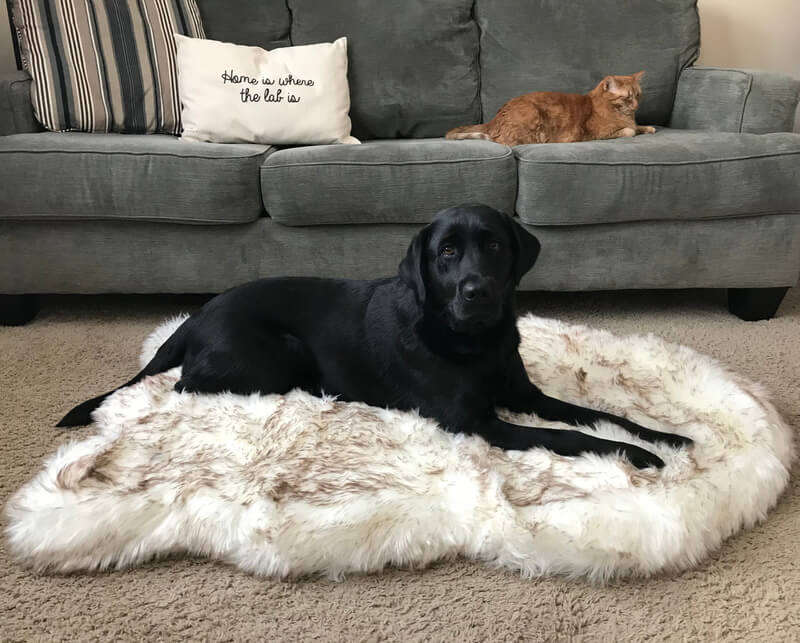
Understanding your dog’s behaviors is one of the keys to making its life better. By getting to know your pet canine, you can provide it with the support, care, and guidance to live the best life with you.
One of the things you can look at to understand your pet is knowing its sleeping patterns. Like humans, dogs have sleeping patterns, such as sleeping schedule, duration of sleep, and sleeping positions.
If your dog sleeps in one position every day or sleeps in a different position each day, it’s always best as a pet parent to understand the significance behind them.
And so, in this article, we’ll explain the meanings behind the top 10 most common dog sleeping positions.
Here are the ten most common dog sleeping positions and the adorable meanings behind them:
1. The Side Sleeper
This is, by far, the most typical dog sleeping position, and in humans, too. When it comes to this posture, your dog is lying on its side with its legs extended.
It is also most common in puppies and older dogs. The general meaning of this sleeping position is that your dog is comfortable and feels safe in your home. It is also the position that gives dogs the deepest sleep, which is the same stage of sleep in humans that provides restoration of the body.
Typically, a dog who sleeps in this position consistently is a dog that’s loyal and trusting.
2. The Donut
This position is when your dog looks like it’s all curled up. The limbs are tucked in close to their body, and the tail seemingly embraces the body, creating a “donut” shape.
The meaning behind this sleeping position is your dog is trying to protect itself, and it is hiding its vital organs from any potential attack, and thus, the position of curling into a ball. It could also mean your dog is cold, as hugging itself will make it warmer.
Dogs who are new to your home or just transferred to a new home will most likely sleep in the donut position as they are still trying to gauge whether or not their new surroundings are safe.
3. The Superman
The Superman pose is when the dog sleeps slumped out on the floor or on a comfortable dog bed. Their belly area is pinned on the ground or the bed, and their back legs are stretched out with their front legs extended in front of them.
The meaning of this sleeping position is that your dog is tired. Your dog may be playful and spend the entire day running and playing around. The dog plops down on any surface to sleep, but this position can also mean that though they are tired, they are ready to wake when you need them to.
4. The Lion’s Pose or the Sphinx
The Lion’s Pose is when your dog sleeps with its head on top of its front legs and its back legs resting on the side of the body. Also known as the Sphinx position, your dog is simply sleeping half-awake as it’s still ready to jump and play at a moment’s notice.
This position usually occurs when your dog sleeps at your feet or by the front door.
5. The Belly Up
This position is when your dog is lying on its back with its belly exposed, and its limbs may be pointing upward. The Belly Up position shows that your dog is comfortable in your home and feels safe. Compared to the Donut position where your dog is hiding its vital organs, the Belly Up position shows that your dog is exposing itself yet feels safe enough to sleep in this pose.
It could also mean that your dog is hot as the belly is the part of the body with the least fur and will most likely cool fast when exposed to air.
When your dog sleeps in this position, you can rest assured that your pet trusts you completely.
6. The Cuddler
The Cudder position is when your dog sleeps on top of you or another dog. It is a sign that your dog has a strong bond with you, is attached to you, or the other animal it sleeps on top of. Cuddlers are affectionate and sweet, which is a way to show you their love and trust.
This is especially common for dogs who sleep on the same bed as their dog owners.
7. The Burrower
The Burrower is a dog that sleeps under blankets, pillows, or clothes. When your dog does this, it means looking for comfort and security. If this bothers you, especially if your dog is spoiling on your clothes or pillows, you can purchase a comfortable dog bed or a memory dog bed that provides a warm embrace to your dog as it sleeps.
Related: Why is my dog sleeping on my pillow?
8. The Back to Back Position
Like the Cuddler, dogs who sleep in the Back to Back position love being around other pets or their dog parent, dogs like these are affectionate, attached, and have a solid bond to their owner or the other animal.
It’s similar to the Cuddler, but the dog is sleeping with its back against your feet, body, or the back of another pet.
9. Head and Neck Elevated
These dogs will typically sleep with their head and neck elevated over a pillow, a couch cushion, or any surface that promotes their head.
Typically, when dogs do this, it could signify a breathing problem, and they are making way for them to sleep while breathing better comfortably.
If your dog sleeps in this position for several days, it might be time to bring it to a vet. This is usually the sleeping behavior of dogs who may be suffering from heart conditions or other health problems.
10. Sleeping on a Cold Surface
If your dog suddenly sleeps on the kitchen floor or any solid surface, it is a vital sign that your dog is feeling hot. The specific positions when your dog sleeps on a cold surface are the Superman and the Lion’s Pose, as they are pressing their body to cool off.
If your dog is sleeping on a cold surface for a few days, consider placing its dog bed in a cooler area or make sure your dog is well hydrated throughout the day.
Dogs sleep an average of 14 hours a day, and their sleeping position tells you a lot about what they feel, what’s going on with their bodies, and their personalities. If you notice them twitching, snoring, moving their feet as if they are running, or barking, don’t worry, as these are average dog sleeping behaviors.
If you’re a new dog parent, getting to know your dog’s behavior through sleeping positions is one of the fastest ways you can understand it. The more you know your dog, the better it is for you to care for it and attend to its needs.
Conclusion
It can be hard to understand a new dog and make sure its needs are met. Fortunately, there are many fast and straightforward ways to understand your dog’s needs and personality. And one of these is understanding your dog’s sleeping position.
These ten dog sleeping positions are the most common, but if you see your dog sleeping unusually and you think it’s not normal, it’s always best to talk to your veterinarian about it.
Related:



